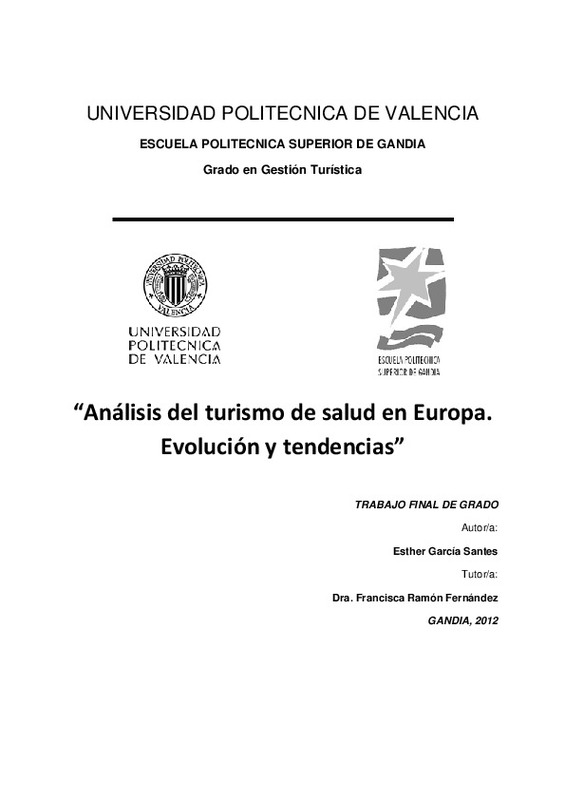JavaScript is disabled for your browser. Some features of this site may not work without it.
Buscar en RiuNet
Listar
Mi cuenta
Estadísticas
Ayuda RiuNet
Admin. UPV
Análisis del turismo de salud en Europa. Evolución y tendencias
Mostrar el registro sencillo del ítem
Ficheros en el ítem
| dc.contributor.advisor | Ramón Fernández, Francisca
|
es_ES |
| dc.contributor.author | García Santes, Esther
|
es_ES |
| dc.date.accessioned | 2012-12-26T10:49:28Z | |
| dc.date.available | 2012-12-26T10:49:28Z | |
| dc.date.created | 2012-09-20 | |
| dc.date.issued | 2012-12-26 | |
| dc.identifier.uri | http://hdl.handle.net/10251/18249 | |
| dc.description.abstract | En este trabajo nos centraremos en el turismo de salud en Europa, su evolución y tendencias. Para ello, por un lado, explicaremos el origen y la evolución del turismo de salud, centrándonos en el turismo de balneario, dado que es una de las tendencias que más ha durado a lo largo del tiempo. En la actualidad las prácticas relacionadas con la salud y el agua las asociamos más a prácticas lúdicas y de ocio que a prácticas medicinales. Sin embargo, el uso de las aguas y termas minerales es una de las formas más antiguas de tratar enfermedades. Por otro lado, analizaremos el turismo de salud desde su origen en la utilización de balnearios termales pasando por las civilizaciones grecorromanas, así como por el movimiento ilustrado, donde los médicos se convirtieron en partidarios del ¿naturalismo terapéutico¿, y así llegar a la aparición de los primeros núcleos turísticos vinculados a balnearios, entre otros detalles que iremos detallando a lo largo de este documento. Además, para entender mejor el turismo de balnearios, se hará un repaso por la historia de tres balnearios que poseen gran relevancia. | es_ES |
| dc.description.abstract | In the present work we will focus in the health tourism in Europe, its evolution and trends. In one hand we will explain the origin and evolution of health tourism, focusing on spa tourism since it is one of the longest lasting trends. Nowadays activities related to health and water are associated more to recreational and leisure practices than to medicinal practices. However the use of water and thermal springs is one of the oldest ways of treating ailments. In the other hand, we will analyze health tourism from its origins in the use of thermal spas by Greco-Roman civilizations, through the Enlightenment movement ¿ when doctors became supporters of ¿therapeutic naturalism¿ ¿ to the first tourist resorts linked to spas; among other details that we will examine throughout this document. Moreover, we will try to understand better the spa tourism making a review through the history of three spas which have relevance | es_ES |
| dc.format.extent | 44 | es_ES |
| dc.language | Español | es_ES |
| dc.publisher | Universitat Politècnica de València | es_ES |
| dc.rights | Reconocimiento - No comercial - Sin obra derivada (by-nc-nd) | es_ES |
| dc.subject | Turismo de salud | es_ES |
| dc.subject | Hidroterapia | es_ES |
| dc.subject | Balneario | es_ES |
| dc.subject | Europa | es_ES |
| dc.subject | Desarrollo turístico | es_ES |
| dc.subject | Turismo | es_ES |
| dc.subject.other | Grado en Turismo-Grau en Turisme | es_ES |
| dc.title | Análisis del turismo de salud en Europa. Evolución y tendencias | es_ES |
| dc.type | Proyecto/Trabajo fin de carrera/grado | es_ES |
| dc.rights.accessRights | Abierto | es_ES |
| dc.contributor.affiliation | Universitat Politècnica de València. Escuela Técnica Superior de Ingeniería del Diseño - Escola Tècnica Superior d'Enginyeria del Disseny | es_ES |
| dc.contributor.affiliation | Universitat Politècnica de València. Departamento de Urbanismo - Departament d'Urbanisme | es_ES |
| dc.description.bibliographicCitation | García Santes, E. (2012). Análisis del turismo de salud en Europa. Evolución y tendencias. Universitat Politècnica de València. http://hdl.handle.net/10251/18249 | es_ES |
| dc.description.accrualMethod | Archivo delegado | es_ES |
Este ítem aparece en la(s) siguiente(s) colección(ones)
-
EPSG - Trabajos académicos [5004]
Escuela Politécnica Superior de Gandia






